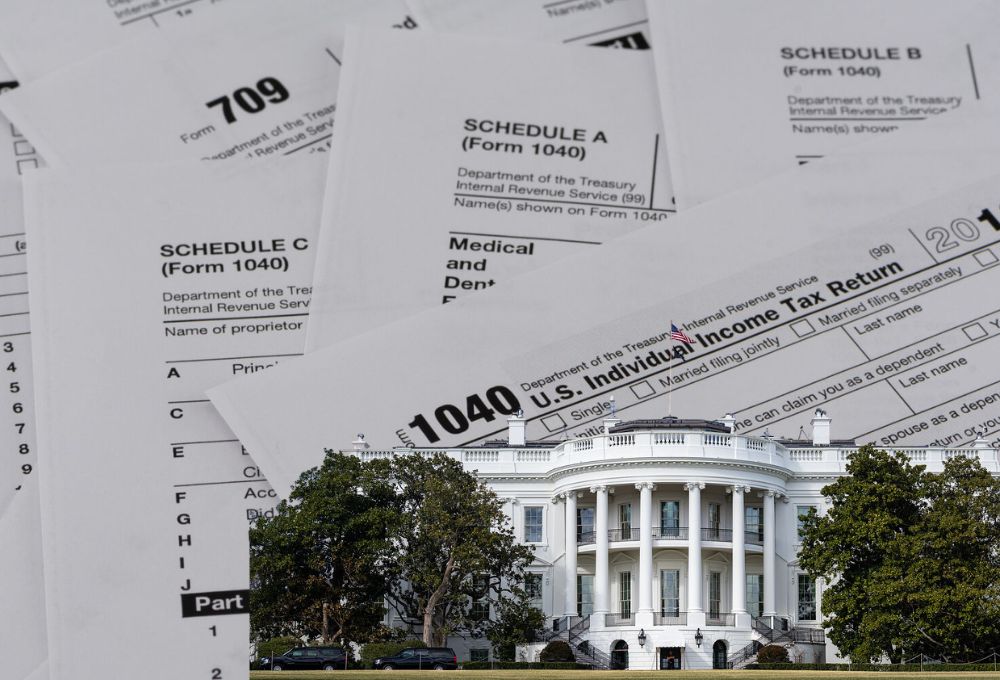Two conflicting theories of economics and taxation are competing for the White House. (Photo illustration by Iowa Capital Dispatch, tax photo via Getty Images; official White House photo)
There was a big old house located at 502 South St. in Toledo, Iowa.
The dwelling has a living room, dining room, kitchen, den, and bath on the first floor, four bedrooms on the second. The basement is divided, with a gray painted cement floor, into a laundry room and the other half has a work bench and a furnace. To the side of the furnace was, in the late 1940s and early 1950s, a coal bin. Once or twice a year, a dump truck would pull up alongside the house, drop a chute down to the window and allow the coal to fill the bin.
My job, when I reached 10 or so, was to shovel the coal into a hopper, which then fed it down to the furnace where it would burn. Every so often, I would open the furnace door and pull out the “clunkers” (burned up coal) and place them in a bucket for emptying in the alley behind the house. The coal would burn, and the heat would spread up throughout the house.
In the spring, along the south side of the building, flowers would be planted and watered by pouring the water on top of the plant, soaking the ground and saturating the roots.
I have now explained all you need to know about the differences between a conservative Republican economist and a Democratic one. Others may try to confuse you by talking about supply and demand, but economic policy is pretty much determined by where you put the emphasis, cutting taxes for the earners at the top of the scale or to those at the lower end.
For conservatives, the supply side theory holds that cutting government revenue (taxes) frees the money up to be used to create jobs to increase the supply of goods and services, thus causing the economy to grow. The more goods that are supplied to the market, the more the economy will grow and revenues will increase.
Democrats hold that emphasis should be placed on government spending, i.e. public works like roads, bridges and infrastructure that creates jobs, which provides the money necessary to purchase goods and grow the economy. Since consumer spending is the major engine that drives economic growth, it also increases government revenue.
One thing is for sure, whether you are liberal or conservative on government policy as it pertains to the tax code: In 2025, it is very likely changes will take place in tax revenue, if only because former President Donald Trump’s 2017 tax reductions are set by law to expire. If Trump wins, the tax cuts remain in place and will likely be expanded. But Vice President Kamala Harris, is not yet supporting further across-the-broad tax reductions, instead targeting increased tax rates for higher-income people, and at least extensions of the tax credits for lower-income individuals, like the earned income tax credit for children and a $25,000 credit for first-time home buyers.
There is a bit of irony in all of this. In 1935 a British economist, John Maynard Keynes, upset conventional thinking that the way out of recessions and depression was to balance the federal budget. Instead, he argued what is needed in down times is increased spending by the government. This proposition was, except within the Roosevelt administration, almost uniformly rejected. But by the 1970s, President Richard Nixon’s economic adviser Milton Friedman admitted, “we are all Keynesians now.”
Taxes: Where do Trump and Harris stand?
All of which brings us to Arthur Laffer and his advocacy that high tax rates cause a loss of government money. He developed the Laffer curve, meant to illustrate that when tax rates get too high, they become counterproductive. Reducing tax rates will motivate people to work and produce more since they get to keep more of their own money, leading to more revenue; raising tax rates produces the opposite effect.
Now maybe to everyone’s surprise, and whether intended or not, Harris’ economic consultants are saying turn the Laffer curve upside down: Reduce taxes on the lower half of the economic scale and you will have individuals with money to spend.
That is really the choice the two candidates offer. If you are a supply conservative proponent, then you should stand in the shade of the elephant. If you believe in the Democratic reversal of Laffer’s proposal, ride a donkey. Pretty simple really — coal in the furnace or water on the flowers, just like when I was a kid.
This column was originally published in the Waterloo Cedar-Falls Courier.

